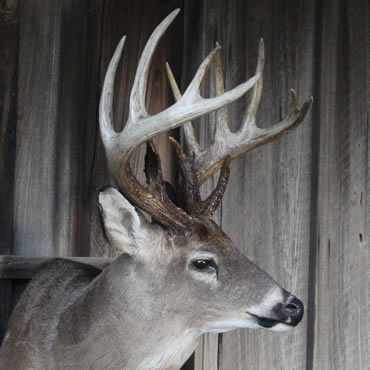By John E. Phillips
Public tracts along Louisiana’s eastern border are known for producing jaw-dropping bucks.
Thirty-year-old Dusty Myers of Oak Grove, Louisiana, donned his hip waders last January to hike to a stand deep within a wildlife management area.
With a rifle in one hand and a climbing stand in the other, Dusty traveled 3/4 mile through flooded timber in an effort to go beyond where other hunters might venture. And the gamble paid off handsomely.
“I’ve been hunting deer with a rifle for 18 years, and I started hunting with a bow two years ago,” Dusty said. “In my wildest dreams, I never thought I’d take a buck like this on public land.”
He was hunting a 7,000-acre WMA in East Carroll Parish during a weeklong gun hunt. That year (2015) was his first time to visit the tract, though his dad, Don, has hunted there for most of his life.
“We generally hunt private land in West Carroll Parish, but I wanted to look at some new scenery,” Dusty said.
Father and son scouted the property two weeks before hunting it, and Dusty found a couple of spots with ample deer sign that seemed perfect for the hunt’s opener.
After two days of not seeing a shooter buck in the most promising spot, he moved to his second favorite setup.
“I saw a couple of small bucks, but the (antler minimum) on this WMA is at least four inch-long points on one side of its rack,” Dusty said. “The two young bucks I saw didn’t meet the requirement.”
On the third day, he scout-hunted by wearing his hip waders and walking through the flooded timber for about 3/4 mile, where he found a ridge of dry land and oak trees dropping plenty of acorns. He also spotted deer tracks and signs of deer feeding, but not any scrapes.
“I didn’t see any indication that other hunters had been on that ridge,” he said. “Most of the hunting pressure was on the opposite side of the WMA from where I was hunting.
“I scouted in the morning, went back, put my stand up that afternoon, and returned the next morning in the dark. As the day brightened, I spotted a 6-point buck,” he said.
In addition, Dusty caught movement in his peripheral vision and saw another buck with at least one impressive antler, moving through thick cover. He soon realized the rack had way more than four inch-long points on that side of its rack.
This WMA contains numerous backwater sloughs and ridges, and Dusty was on one near the oak trees. Although the ridge was fairly open, there was one patch of thick cover where he had seen the buck.
Dusty figured if the left side of the deer’s rack was as big and tall as the right side, it was a really good buck.
He turned, hefted his rifle to his shoulder and looked for a clearing along the deer’s route to get a clear shot at the biggest buck he’d ever seen.
“I finally spotted an opening about 60 yards from my stand and put my crosshairs on that spot,” he said. “I planned to shoot when I saw the buck’s shoulder.”
Seconds later, Dusty squeezed the .30-06’s trigger, knowing he’d made a lethal shot by the way the buck came running out of the thicket. However, the big buck next made a circle and came right under his treestand, causing him to say, “My lord … That’s a monster!”
Dusty didn’t want the whitetail to get away, so he fired a second shot from 12 yards. The buck went down instantly.
 “I immediately got down from my tree, but I still had to sit because I was so shook up,” he admitted. “I’d never taken anything bigger than a 122-inch 8-pointer before that. I felt certain this buck would score more than 150.
“I immediately got down from my tree, but I still had to sit because I was so shook up,” he admitted. “I’d never taken anything bigger than a 122-inch 8-pointer before that. I felt certain this buck would score more than 150.
“Unnerved, I finally went to the deer, sat down and rubbed its antlers. I never expected to see a buck that size on public land,” he continued. “I had initially hoped to see a 130-inch buck. I never dreamed of one this big.”
After Dusty calmed down, he called his dad and told him he’d shot a monster. “I think he’s bigger than your 177-inch 11-pointer,” he said.
Dusty says the rule on the WMA is for successful hunters to take their gun back to their vehicles before they can drive a four-wheeler in to retrieve a deer. So he met his dad at the truck, and they returned on the ATV with some rope.
“We tied the rope onto the deer’s antlers and dragged it out through the water, until we got to dry land where we could load it on the four-wheeler,” Dusty said. “Dragging that huge buck through the water helped support it until we could tow it to dry land and carry it the rest of the way to the truck.”
This article was published in the April 2017 edition of Rack Magazine. Subscribe today to have Rack Magazine delivered to your home.
Read Recent RACK Articles: • Do-over: Two years after his arrow shaved hairs off an impressive whitetail’s belly, this Kentuckian tasted déjà vu.
• Throwback: The rain in Woodford County, Kentucky, falls mainly on the mane, or it once did.
• Tagged Out in Two: How long does it take for deer to forget a boom? Two hours, apparently.